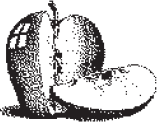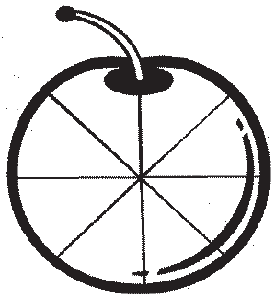A SLICE OF PLANET EARTH
| Subject: Science, Mathematics Skills: Computing, Listening, Observation Duration: 30 minutes (or more depending on depth and discussion) Setting: Classroom Materials: —apple —plastic knife —napkin —copies of the Slice of Planet Earth math worksheet for each student NOTE: Some teachers prefer to make this activity truly “hands-on” by having each student or pair of students cut their own apple according to the teacher’s instructions. If you feel comfortable with students using plastic knives in the classroom, you may want to consider this option. Otherwise, you can demonstrate the apple cutting at the front of the class. Michigan Curriculum Framework Content Standards and Benchmarks: —Science (EG)V.1.E1: Strand V. Using Earth Science Knowledge, Standard 1. Geosphere, Benchmark E1. Describe major features of the earth’s surface. (Key concepts: Types of landforms - mountains, plains, valleys; bodies of water - rivers, oceans, lakes. Real-world contexts: Examples of Michigan surface features, such as hills, valleys, rivers, waterfalls, Great Lakes; pictures of global land features, including mountains, deserts.) —Mathematics IV.2.1: Strand IV. Number Sense and Numeration, Standard 2. Representation and Uses of Numbers, Benchmark 1. Represent whole numbers, fractions and decimals using concrete, pictorial and symbolic representations. Kent County Collaborative Core Curriculum (KC4): —Science: 3:5 4:4 —Mathematics: 3:1, 3:2, 3:3, 3:5, 3:6 4:2, 4:3, 4:7, 4:8, 4:11 5:1, 5:2, 5:3, 5:4, 5:6, 5:11, 5:12 |
OVERVIEW
By observing (or performing) the slicing of an
apple, students become aware of the small
fraction of the Earth’s limited land resources that
support all human life.
OBJECTIVES
After participating in this activity, students will be
able to:
• Deduce that only a small fraction of the Earth supports
all human life.
• Understand fractions when counting and coloringpieces.
• Describe major features of the Earth’s surface.
BACKGROUND
It is important to realize that land on our planet, or
geosphere,
makes up only about 1/4 of the Earth’s total surface. Land features
include mountains, deserts, polar regions, valleys, plains, prairie,
farmland, forests, and wetlands. Each of these features shares a
portion of the total amount of land on the planet.
Students tend to think of the land on the planet as being limitless,
yet simple calculations demonstrate the fact that the amount of
land is limited. The quality of this limited amount of land must be
maintained. Human beings have a responsibility to conserve land,
use it wisely and protect its quality.
The purpose of this lesson is for students to acquire an
understanding of the fragile nature of land as a resource.
PROCEDURE
As you go through this brief demonstration, ask the
students the
questions that are in quotation marks before revealing the answers
noted in italics.
1. Show the apple to the class. “For this exercise, this apple
represents our planet.”
2. Slice the apple into quarters.
3. Hold out three quarters. “What does this part of the apple
apple represent?” They represent the water and oceans of the
world.
4. “What fraction is left?” 1/4 “This represents all the land on
the earth.”
5. Slice this section in half. Hold up one of the pieces. “This
portion represents the areas where people can’t live:
the polar areas, deserts, swamps, very high or rocky
mountains.” Set this piece aside.
6. Hold up the other piece. “What fraction of the whole apple is
this?” 1/8 “This piece represents the land where people can
live, but not all of the soil is good for growing food.”
7. Slice the 1/8 piece into four equal sections. Hold three of the
sections in one hand and one section in the other. Hold out
the single section. “What fraction of the apple is this?” 1/32
8. Hold out the three sections in your left hand. “These 3/32
represent the areas too rocky, too wet, too cold, too steep,
or with too poor soil to actually grow food. They also contain
the cities, suburbs, highways, shopping centers, schools,
parks, factories, parking lots and other places people live,
work, or use in other ways, but can no longer grow food.”
9. Carefully peel the 1/32 slice of Earth. Hold this peel out so they
can see it. “This tiny bit of peeling represents the surface, the
very thin layer of the Earth’s crust upon which food is grown to
feed everyone on Earth. It is less than five feet deep. It takes
100 years for one inch of this topsoil to form.”
10. For dramatic effect, you can eat the small piece of apple
peel, saying, “If we do not take care of this land, it will be
gone.”
11. Discuss with the students their observations.
• Did they realize the small fraction of Earth that supports
all human life? What were the other features of the earth’s
surface?
• What things cause land erosion? One example is
deforestation and loss of natural vegetation. Branches and
leaves shelter the soil from the force of rain and wind.
Root systems help to hold soil in place. So when trees and
vegetation are lost, the soil is blown and washed away.
• What are some ways we could help to preserve natural
open-space and farmland? By choosing not to build
anything on land that could be used to grow food. Or, when
building is necessary, use wise land use planning and
building practices.
12. Assign students to complete the Slice of Planet Earth math
worksheet. This can be done in pairs, individually, or for
homework. It can also be done while performing the slicing
activity or during a review of the slicing.
13. Have students practice retelling the Slice of Planet Earth
activity to their partner. Allow them to use apple pieces or a
worksheet to explain different parts of the Earth. Assign the
students to also retell the story as homework.
ASSESSMENT OPTIONS
1. Have each student write the ending to this statement,
“I learned
that...” Was the student surprised by the tiny piece of potential
farmland at the end of the lesson? If potential farmland is 1/32
of the earth’s surface, what are the other features of the earth’s
surface? Name and/or draw these features.
2. Assess the mathematical understanding of fractions by
evaluating the students’ worksheets for completeness and
accuracy.
TEACHER MEMOS

Directions: Fill in the missing answers and follow
the
instructions.

1. The apple, representing the earth, is divided into
_________
equal parts.
2. Color 3/4 of the apple blue. This represents all the water on
earth.
3. Continue dividing the whole apple into 32 equal parts.
4. Outline the remaining 1/4 of the apple green. This represents all the
land on earth.
5. Fill in the missing numerator.
A.  of the apple are blue, and represent water
covering the earth.
of the apple are blue, and represent water
covering the earth.
B.  of the apple are outlined in green,
representing land on the earth.
of the apple are outlined in green,
representing land on the earth.
6. Color in 1/2 of the green section with brown. This portion represents
land where people can not live such as mountain tops, deserts, and polar
caps.
7. Color in 3/32 of the remaining green section with red. This section
represents cities and unfarmable land such as wetlands and rocky areas
8. Fill in the missing numerator.
A. of the apple are unlivable (brown).
B. of the apple are unfarmable (red).
C. of the apple is left for farmland and open space! (white)
9. Actually, only the skin, or crust of the earth, is available for farmland.
Circle the outside edge of the remaining 1/32 green section, and label it
“Farmland”.
EXTRA CREDIT: On plain paper, draw 32 apple pieces.
A. Color 3/4 of the pieces blue. These represent water covering the earth.
B. Color 1/8 of the pieces brown. These represent land where people cannot
live such as mountain tops, deserts, and polar caps.
C. Color 3/32 of the pieces red. These represent cities and unfarmable land
such as wetlands and rocky areas.
D. Outline in green the last white 1/32 piece, this represents open space
and land available for farming on the earth‛s crust. Label it “Farmland”.


